苏教版小学科学新版四年级上册科学15.生活中的电课件
- 格式:ppt
- 大小:8.43 MB
- 文档页数:23
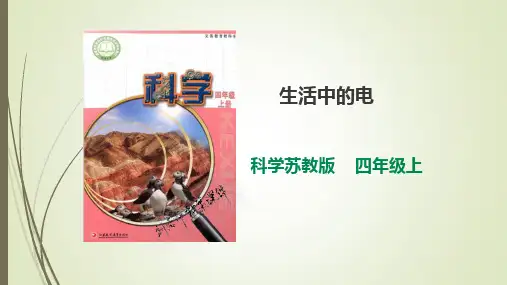
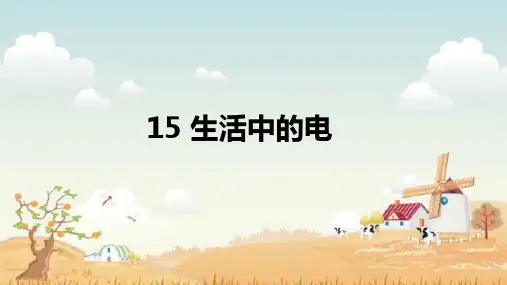
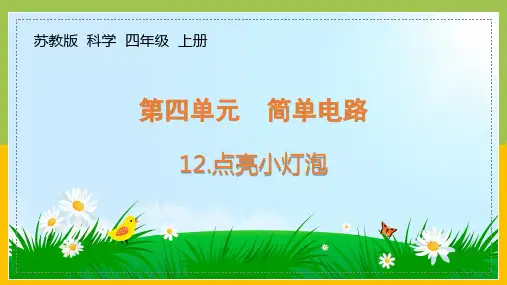
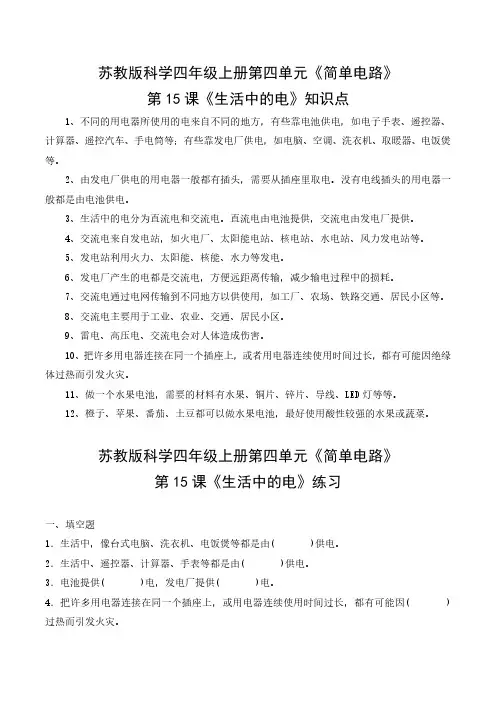
苏教版科学四年级上册第四单元《简单电路》第15课《生活中的电》知识点1、不同的用电器所使用的电来自不同的地方,有些靠电池供电,如电子手表、遥控器、计算器、遥控汽车、手电筒等;有些靠发电厂供电,如电脑、空调、洗衣机、取暖器、电饭煲等。
2、由发电厂供电的用电器一般都有插头,需要从插座里取电。
没有电线插头的用电器一般都是由电池供电。
3、生活中的电分为直流电和交流电。
直流电由电池提供,交流电由发电厂提供。
4、交流电来自发电站,如火电厂、太阳能电站、核电站、水电站、风力发电站等。
5、发电站利用火力、太阳能、核能、水力等发电。
6、发电厂产生的电都是交流电,方便远距离传输,减少输电过程中的损耗。
7、交流电通过电网传输到不同地方以供使用,如工厂、农场、铁路交通、居民小区等。
8、交流电主要用于工业、农业、交通、居民小区。
9、雷电、高压电、交流电会对人体造成伤害。
10、把许多用电器连接在同一个插座上,或者用电器连续使用时间过长,都有可能因绝缘体过热而引发火灾。
11、做一个水果电池,需要的材料有水果、铜片、锌片、导线、LED灯等等。
12、橙子、苹果、番茄、土豆都可以做水果电池,最好使用酸性较强的水果或蔬菜。
苏教版科学四年级上册第四单元《简单电路》第15课《生活中的电》练习一、填空题1.生活中,像台式电脑、洗衣机、电饭煲等都是由( )供电。
2.生活中、遥控器、计算器、手表等都是由( )供电。
3.电池提供( )电,发电厂提供( )电。
4.把许多用电器连接在同一个插座上,或用电器连续使用时间过长,都有可能因( )过热而引发火灾。
5.用橙子制作水果电池时,如果灯不亮,可以( )。
6.制作水果电池需要的材料有( )、( )、( )、( )、( )。
二、判断题。
1.我们要提高安全用电的意识。
( )2.为了放大实验效果,可以采用插座里电进行电学实验。
( )3.在野外遇见雷雨天气,最好不要躲在大树下避雨。
( )4.把多个用电器连接在同一插座上容易发生危险。
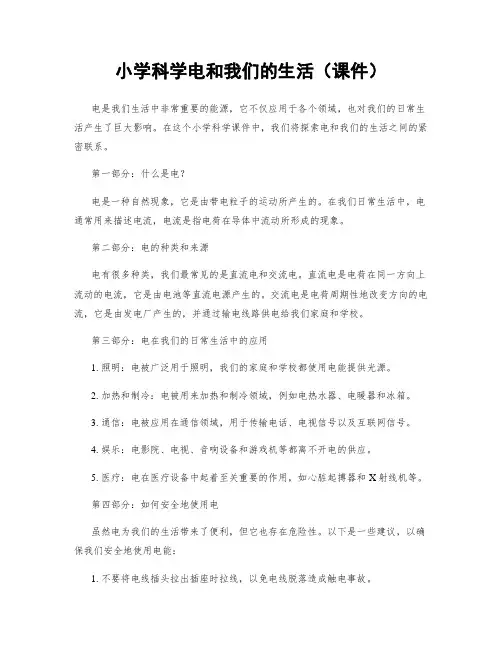
小学科学电和我们的生活(课件)电是我们生活中非常重要的能源,它不仅应用于各个领域,也对我们的日常生活产生了巨大影响。
在这个小学科学课件中,我们将探索电和我们的生活之间的紧密联系。
第一部分:什么是电?电是一种自然现象,它是由带电粒子的运动所产生的。
在我们日常生活中,电通常用来描述电流,电流是指电荷在导体中流动所形成的现象。
第二部分:电的种类和来源电有很多种类,我们最常见的是直流电和交流电。
直流电是电荷在同一方向上流动的电流,它是由电池等直流电源产生的。
交流电是电荷周期性地改变方向的电流,它是由发电厂产生的,并通过输电线路供电给我们家庭和学校。
第三部分:电在我们的日常生活中的应用1. 照明:电被广泛用于照明,我们的家庭和学校都使用电能提供光源。
2. 加热和制冷:电被用来加热和制冷领域,例如电热水器、电暖器和冰箱。
3. 通信:电被应用在通信领域,用于传输电话、电视信号以及互联网信号。
4. 娱乐:电影院、电视、音响设备和游戏机等都离不开电的供应。
5. 医疗:电在医疗设备中起着至关重要的作用,如心脏起搏器和X射线机等。
第四部分:如何安全地使用电虽然电为我们的生活带来了便利,但它也存在危险性。
以下是一些建议,以确保我们安全地使用电能:1. 不要将电线插头拉出插座时拉线,以免电线脱落造成触电事故。
2. 不要触摸带电的插头或电器开关。
3. 不要在水或潮湿的环境中使用电器。
4. 不要在电器故障时试图修复,应该请专业人士检修。
5. 不要同时插入太多电器到同一个插座中,以免电线过载。
总结:在这个小学科学课件中,我们学习了电和我们的生活之间的密切联系。
电是一种被广泛使用的能源,它应用于照明、加热和制冷、通信、娱乐以及医疗等领域。
然而,我们也要注意电的安全使用,避免触电事故的发生。
通过学习这些内容,我们希望能够更好地理解和利用电能,将其运用到我们的生活中,为我们的社会做出贡献。
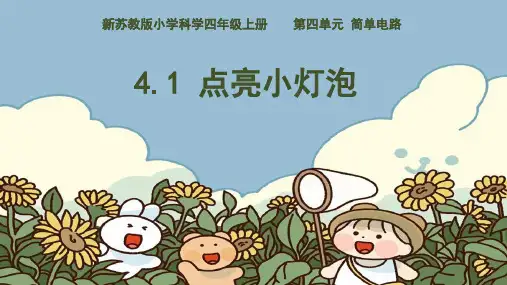
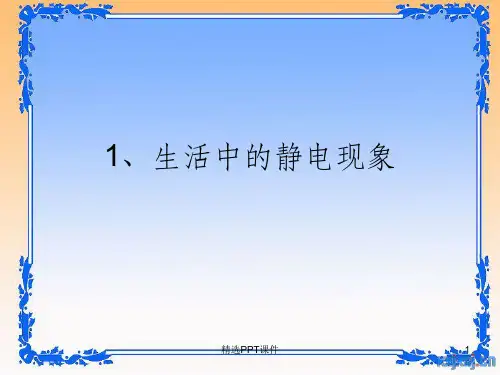
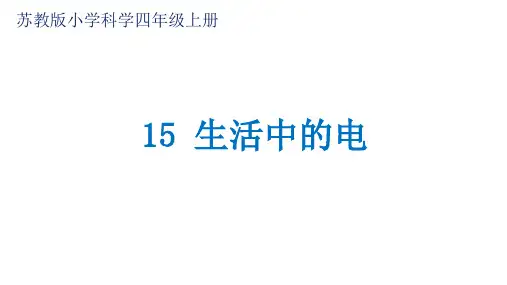
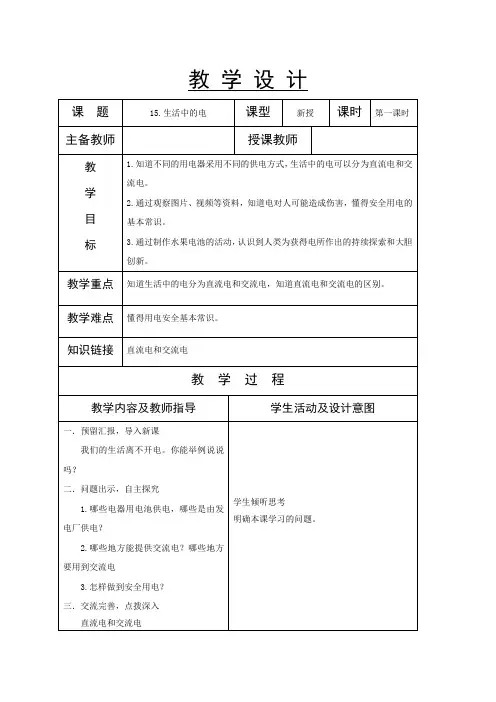
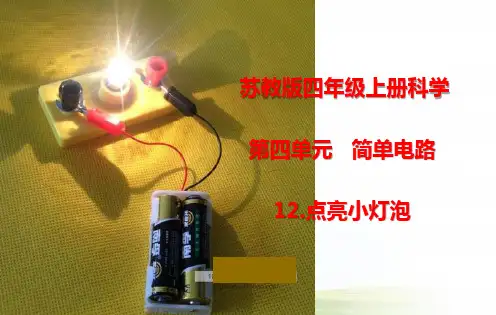
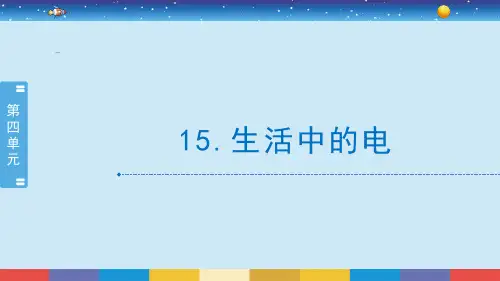
小学科学生活中的电(课件)Title: The Wonders of Electricity in Elementary School LifeIntroduction:Electricity is a fundamental part of our daily lives, and even elementary school students can learn about its various applications and importance. This presentation aims to educate young learners about the wonders of electricity by showcasing its relevance in their daily lives. Let us embark on an exciting journey through this educational experience focused on electricity at the elementary school level.1. What is Electricity?Electricity is a form of energy created by the movement of electrons. It powers the devices and equipment we use in our daily lives. Students will learn about the basic concept of electricity, how it is generated, and its importance in their everyday activities.2. Exploring Electric Circuits:A. Understanding circuits:Elementary school students will learn about the basics of electric circuits. They will understand that a circuit consists of a path through which electricity flows, connecting various components such as batteries, wires, and bulbs.B. Components of a circuit:Students will be introduced to the essential components of an electric circuit. They will learn about switches, conductors, insulators, and how these components contribute to the flow of electricity.C. Building simple circuits:To enhance their understanding, students will have the opportunity to participate in hands-on activities. They will learn to build simple circuits using batteries, wires, bulbs, and switches, enabling them to observe the transformation of electrical energy into light.3. Safety Measures and Household Electricity:A. Electrical safety at home:It is crucial for elementary school students to understand the importance of electrical safety. They will be introduced to concepts such as electrical hazards, the proper handling of electrical appliances, and the significance of adult supervision.B. Understanding household appliances:Students will explore common household appliances such as refrigerators, televisions, and computers. They will learn about the role of electricity in these devices, how they function, and how to use them responsibly.4. The Impact of Electricity on Our Environment:A. Renewable vs. non-renewable energy sources:Elementary school students will gain awareness about the environmental impact of electricity generation. They will learn about the difference between renewable and non-renewable energy sources and how our choices impact the planet.B. Energy conservation:Education regarding energy conservation starts at an early age. Students will be encouraged to adopt habits such as turning off lights when leaving a room, using natural light instead of electric light, and unplugging devices when not in use.5. Fun with Static Electricity:A. Introducing static electricity:Elementary school students will be introduced to the concept of static electricity through interactive experiments. They will learn how static charges are formed and experience the thrill of seeing objects attract or repel due to static electricity.B. Lightning and thunder:Students will explore how static electricity manifests as lightning and thunder during thunderstorms. They will understand the scientific explanations behind these natural phenomena.Conclusion:Understanding the wonders of electricity is essential for elementary school students. This presentation aims to broaden their knowledge and curiosity about electricity and its various applications in their daily lives. By cultivating an appreciation for this incredible energy source, young learners can become responsible and environmentally conscious citizens, making informed decisions about energy consumption. Let's continue exploring and discovering the wonders of electricity!。